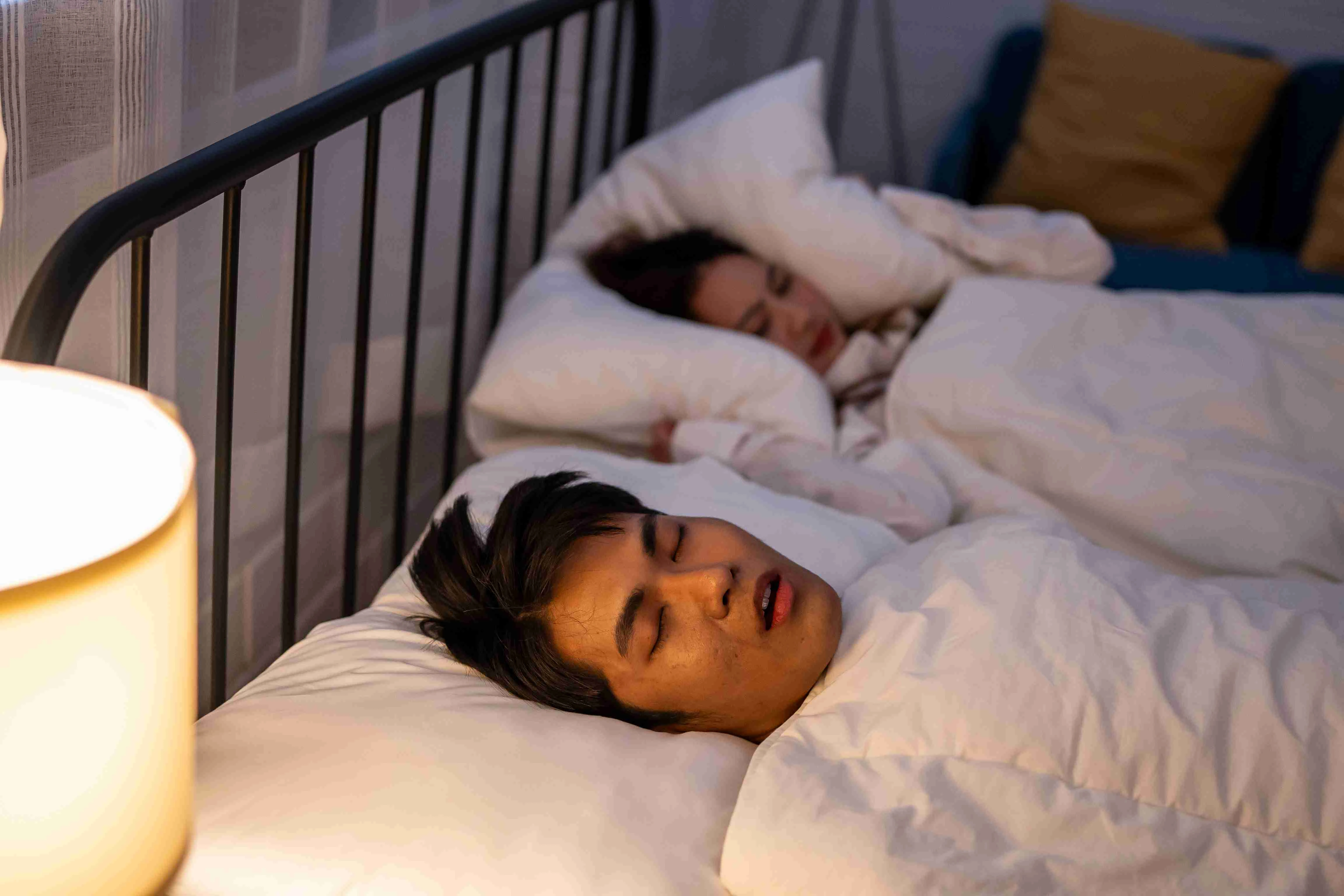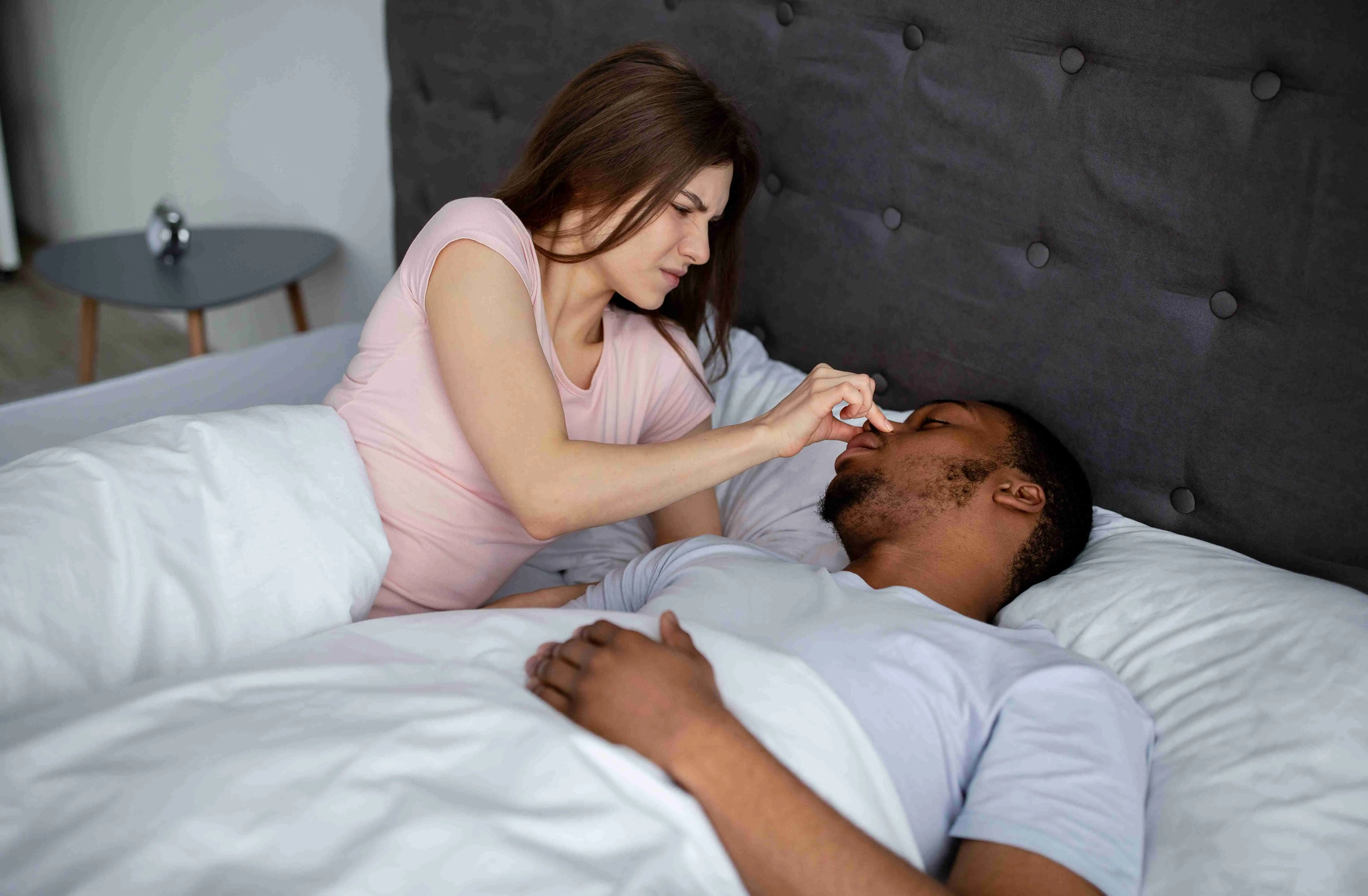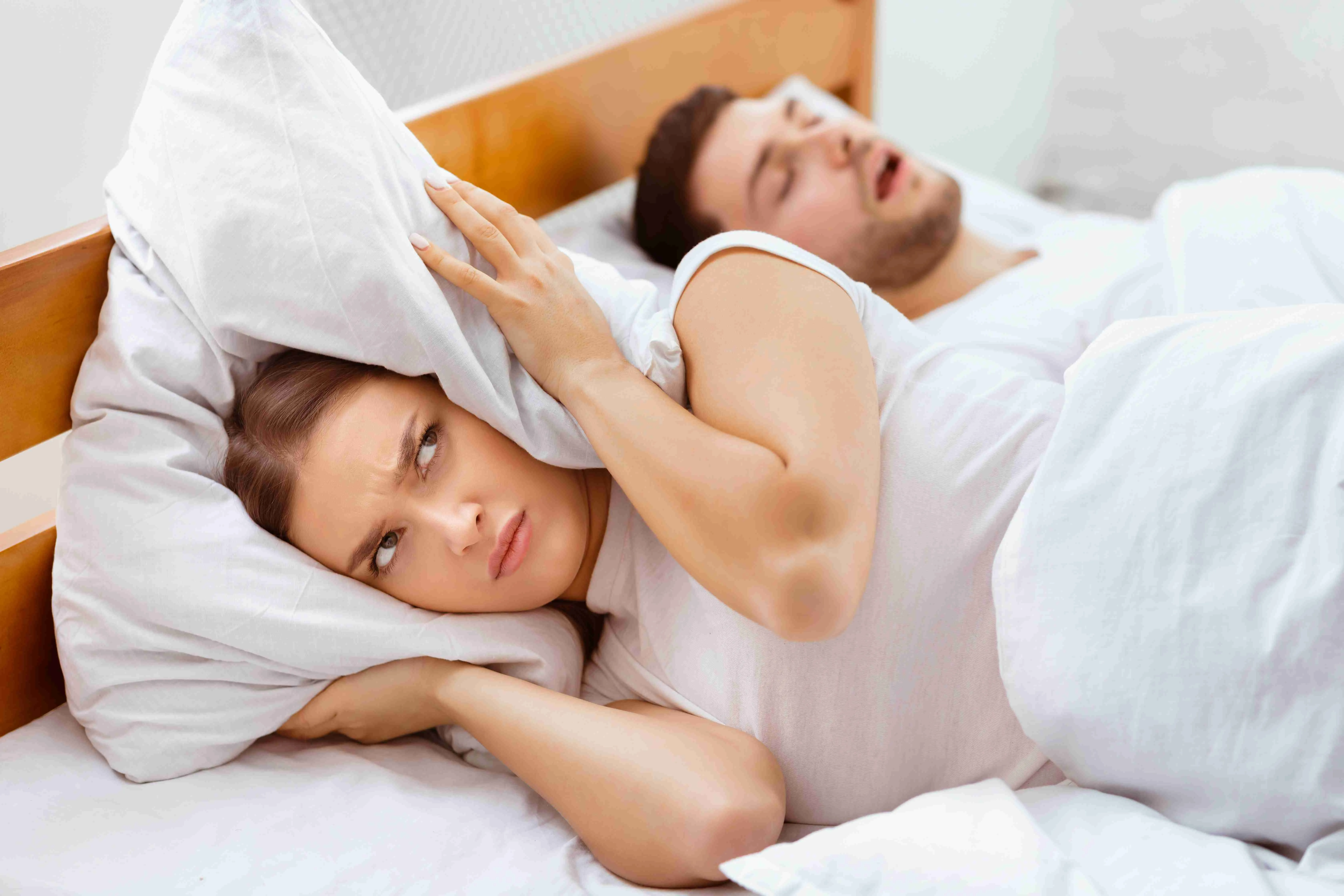Quality sleep is one of the key factors in a happy and productive life; however, multiple sleeping disorders can disrupt sleep quality, and one of the most prominent is sleep apnea.
In this article, we will talk about the different types of sleep apnea, the symptoms of sleep apnea, and the best sleeping position for sleep apnea.
What is sleep apnea?

Sleep apnea is a sleep-related breathing disorder characterized by pauses in breathing or instances of shallow or infrequent breathing during sleep.
These pauses can last from a few seconds to a few minutes and occur multiple times throughout the night.
Types of Sleep Apnea
There are three main types of sleep apnea: obstructive sleep apnea (OSA), central sleep apnea (CSA), and complex sleep apnea syndrome (CompSAS). Each type has its properties.
- Obstructive Sleep Apnea: Obstructive sleep apnea is the most common type and occurs when the airway becomes partially or completely blocked during sleep. This blockage can be due to several factors such as relaxed throat muscles, enlarged tonsils, or excess weight.
- Central Sleep Apnea: Central sleep apnea is less common and occurs when the brain fails to send proper signals to the muscles that control breathing. Unlike OSA, there is no physical obstruction in the airway. Instead, the respiratory system becomes unstable, causing pauses in breathing.
- Complex Sleep Apnea Syndrome: Complex sleep apnea syndrome is a combination of both obstructive and central sleep apnea. It occurs when a person initially has OSA but develops central sleep apnea after receiving treatment with continuous positive airway pressure (CPAP) therapy.
Symptoms
Symptoms of sleep apnea could change from one person to another; for example, sleep apnea symptoms in women can be different than in men.
Symptoms can also vary depending on the degree of the sleep apnea, whether it’s severe sleep apnea, moderate sleep apnea, or mild sleep apnea.
It's vital, if any of these symptoms persist, to consult with a healthcare professional to find out the best ways to combat them.
- Snoring: One of the most common signs of sleep apnea is loud and persistent snoring. This occurs because the airway becomes partially or completely blocked, causing the person to struggle to breathe properly.
- Dry Mouth: One of the obstructive sleep apnea symptoms is dry mouth. This occurs because when the airway is blocked, the person breathes through their mouth instead of their nose. This can lead to dryness and discomfort in the mouth and throat.
- Daytime Sleepiness: Due to the interrupted sleep patterns caused by the repeated pauses in breathing, individuals with sleep apnea often feel fatigued during the day.
- Morning Headaches: Repeated disruptions in breathing during the night can lead to a decrease in oxygen levels in the blood and an increase in carbon dioxide levels. This can result in headaches upon awakening in the morning.
- Frequent Wake-ups During the Night: This means that individuals with sleep apnea may find themselves waking up multiple times throughout the night, often gasping for air or feeling a choking sensation.
- Reduced Focus: One of the side effects of sleep apnea is reduced focus. This is because the interrupted sleep patterns disrupt the normal functioning of the brain, preventing individuals from getting the quality rest they need to recharge. As a result, individuals with sleep apnea may find it difficult to concentrate on tasks, stay alert, and retain information.
How Sleeping Positions Affect Sleep Apnea
Sleeping positions play a crucial role in the occurrence and severity of sleep apnea. Sleeping on one's side is generally recommended as it helps keep the airway open and reduces breathing pauses. Conversely, sleeping on your stomach can exacerbate sleep apnea symptoms.
Individuals with sleep apnea need to be aware of their sleeping position and make necessary adjustments to improve their overall sleep quality and manage their condition effectively.
What is the best position for sleep apnea?

While there is no one-size-fits-all answer to the best sleeping position for sleep apnea, it’s important to experiment with different sleep positions and consult with a healthcare professional to determine the most suitable sleeping position for your specific case of sleep apnea.
Side Sleeping
One of the best positions to alleviate the symptoms of sleep apnea is side sleeping. When you sleep on your side, it helps to keep your airways open and reduces the likelihood of obstructions. However, it is essential to know how to sleep safely on your side to maximize its benefits.
Using a supportive pillow that keeps your head and neck aligned with your spine can help maintain proper airflow. Additionally, using a body pillow or placing a pillow between your knees can provide added comfort and support for your body.
Stomach Sleeping
Sleeping on your stomach can help keep the airways open and reduce the likelihood of obstruction during sleep. However, it is important to note that not everyone with sleep apnea may find this position comfortable or effective, and individual preferences and needs should be taken into consideration.
If you choose to sleep on your stomach, make sure to do so safely by using a supportive pillow and avoiding any excess pressure on your neck or spine.
Back Sleeping
Back sleeping is often recommended as the safest option. Sleeping on your back helps to keep the airways open and reduces the chances of blockages or obstructions that can lead to interrupted breathing.
Additionally, back sleeping allows for better alignment of the body, which can alleviate pressure on certain areas and promote more restful sleep.
To sleep safely on your back, it is recommended to use a supportive pillow and mattress to maintain proper spinal alignment and to avoid any additional pillows that may tilt the head forward, restricting airflow.
Tips for Improving Sleep Apnea with the Right Sleeping Position

Incorporating these tips into your nightly routine can significantly improve your overall sleep health and provide relief from the symptoms of sleep apnea.
Elevate Your Head Slightly
One way to improve sleep apnea is by adopting the right sleeping position that elevates your head while you’re asleep because elevating your head while sleeping can help open up the airways and reduce the frequency of breathing pauses.
Use Pillows Strategically
Using a pillow can be useful in elevating your head; by propping up your head with additional pillows and keeping your head raised, you can promote better airflow and minimize the risk of apnea episodes.
Adjust the Sleep Environment
Make sure your bedroom is quiet, dark, and comfortable. Use earplugs or a white noise machine to block out any noise that may disrupt your sleep.
Altering Sleep Positions
Altering sleep positions can also play a crucial role in improving sleep apnea symptoms. One recommended sleeping position for individuals with sleep apnea is the Semi-Fowler's position.
This position involves elevating the upper body by using pillows or an adjustable bed, which helps to keep the airways open and reduces the likelihood of obstructed breathing.
Another beneficial sleeping position for individuals with sleep apnea is sleeping on the left side.
This position can help to alleviate symptoms by preventing the collapse of the airways and reducing the occurrence of obstructive events during sleep.
Reducing Alcohol Consumption
One important step to alleviate the symptoms of sleep apnea is reducing alcohol consumption.
Alcohol relaxes the muscles in the throat, making it easier for them to collapse and obstruct the airway. By limiting or eliminating alcohol intake, you can reduce the severity of sleep apnea symptoms.
CPAP therapy
Another effective treatment for sleep apnea is continuous positive airway pressure (CPAP) therapy.
This sleep apnea machine, or PAP therapy, involves wearing a mask connected to a machine that delivers pressurized air to keep the airway open during sleep.
Using a CPAP machine consistently can significantly improve sleep apnea symptoms and reduce the risk of associated complications.
FAQs
What happens if you don't treat sleep apnea?
One of the most noticeable effects of untreated sleep apnea is daytime fatigue and excessive sleepiness. This can lead to decreased productivity, difficulties concentrating, and an increased risk of accidents, both at work and while driving.
How do you know if you have sleep apnea?
The first step is usually a thorough medical history and physical examination and sometimes a sleep study. This helps the healthcare provider understand the patient's symptoms and identify any underlying health conditions that may contribute to sleep apnea.
What are the sleep apnea treatment options?
One common treatment is CPAP therapy, which involves wearing a mask over the nose and/or mouth during sleep. The mask is connected to a machine that delivers a constant flow of air.
Are there special pillows for sleep apnea sufferers?
Yes, there are. One type of pillow commonly used by sleep apnea sufferers is the contour pillow. This pillow type is shaped to cradle the head and neck, allowing for better airflow and reducing the risk of airway blockage.
How common is sleep apnea?
It is estimated that around 22 million Americans suffer from some form of sleep apnea, making it a prevalent condition. However, it is important to note that many cases of sleep apnea go undiagnosed, so the actual number of individuals affected may be even higher.
Can sleep apnea kill you?
Over time, the lack of oxygen caused by sleep apnea can put a strain on vital organs such as the heart and brain, increasing the risk of cardiovascular diseases and stroke. It is crucial to seek medical attention and follow proper treatment methods to mitigate the potentially life-threatening effects of sleep apnea.
Conclusion
Finding the best sleeping position for sleep apnea can greatly improve the quality of sleep cycles for individuals with this condition.
While there is no one-size-fits-all answer, there are certain positions that can help alleviate symptoms and promote better breathing during sleep. One such position is sleeping on your side, as this can help keep the airways open and prevent them from collapsing.
Elevating the head and upper body with a pillow can also be beneficial, as it helps to reduce the pressure on the airways and allows for easier breathing.
Ultimately, individuals with sleep apnea need to experiment with different sleeping positions and find what works best for them to achieve a good night's rest.
Jessica H.
Jessica is a reviewer, writer, and sleep enthusiast at Sleepiverse. Jessica graduated with her master's degree in Nursing research and education. She is a registered nurse and currently works in the Intensive Care Unit. Since becoming a nurse, Jessica has worked the night shift, which means a disrupted sleep schedule. Knowing she needed to function at her best while caring for patients at night, she spent a lot of time researching how to sleep well with a difficult schedule.


